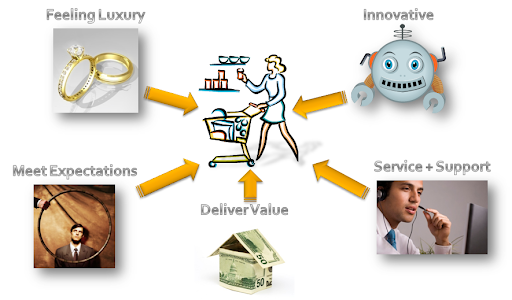When I was running today on my usual track, I was thinking about the new personalized customer experience and what is so new about it. I came to the conclusion that we already had this concept in the past. It is not so new!

In the corner shops in the past, there was a truly personalized experience. The lady behind the counter knew all her customers personally and treated everybody different. She recommended products which she believed were of good quality and delivered some value to the consumer.
By sharing the experience of other buyers of the same product she could back up her own preferences. Customers met in the store and shared their experiences themselves - positive and negative ones.
The conversations were not limited to products, though. The people that met in the store chatted about their daily life and shared stories about family and friends. Sometimes interested people would spend some more thoughts about peoples problems and create solutions (could be new products or services).

With the globalization in the last decades the consumer got bombarded with new and cheap products from all over the world.
Innovative products reached millions of customers without any thought about their special needs or potential problems with the usage in different environments. No need for extensive testing or customer feedback - competition was fought on price and features.
As customers started buying in big stores without the personal support from the personnel or via the internet without any personal contact, there was no way to make problems public about products or services. Other consumers would buy the products because of the nice and shiny advertisements and producers made good money with selling bad products.
Marketing was made by analysts that gathered data, ran some algorithms on them and created products they believed had a good potential on the market. Supported by massive TV, radio and print campaigns the products were introduced to the market and produced with an efficient and cost effective SCM. No one ever spend any thoughts on products and services could be personalized and how the customer could be involved in the creation and evolution of them. And actually for quite a while there was simply no way to do this!!
But now there is way (!) and companies need to re-think their process of inventing, marketing and producing goods. The empowered customer is now able to share her/his experience with millions of other users via the internet and there are ways to create a personalized experience even for thousands or hundreds of thousand users.
So isn't CRM 2.0 a kind of 'back to the roots' thing? Weren't we as customers missing the personal component of the selling-buying process in the past years - but still want to keep the advantages of a global marketplace where companies have to compete globally on price, features and quality?
Technorati Tags: CRM 2.0, Personalization, Customer Experience

In the corner shops in the past, there was a truly personalized experience. The lady behind the counter knew all her customers personally and treated everybody different. She recommended products which she believed were of good quality and delivered some value to the consumer.
By sharing the experience of other buyers of the same product she could back up her own preferences. Customers met in the store and shared their experiences themselves - positive and negative ones.
The conversations were not limited to products, though. The people that met in the store chatted about their daily life and shared stories about family and friends. Sometimes interested people would spend some more thoughts about peoples problems and create solutions (could be new products or services).

With the globalization in the last decades the consumer got bombarded with new and cheap products from all over the world.
Innovative products reached millions of customers without any thought about their special needs or potential problems with the usage in different environments. No need for extensive testing or customer feedback - competition was fought on price and features.
As customers started buying in big stores without the personal support from the personnel or via the internet without any personal contact, there was no way to make problems public about products or services. Other consumers would buy the products because of the nice and shiny advertisements and producers made good money with selling bad products.
Marketing was made by analysts that gathered data, ran some algorithms on them and created products they believed had a good potential on the market. Supported by massive TV, radio and print campaigns the products were introduced to the market and produced with an efficient and cost effective SCM. No one ever spend any thoughts on products and services could be personalized and how the customer could be involved in the creation and evolution of them. And actually for quite a while there was simply no way to do this!!
But now there is way (!) and companies need to re-think their process of inventing, marketing and producing goods. The empowered customer is now able to share her/his experience with millions of other users via the internet and there are ways to create a personalized experience even for thousands or hundreds of thousand users.
So isn't CRM 2.0 a kind of 'back to the roots' thing? Weren't we as customers missing the personal component of the selling-buying process in the past years - but still want to keep the advantages of a global marketplace where companies have to compete globally on price, features and quality?
Technorati Tags: CRM 2.0, Personalization, Customer Experience






